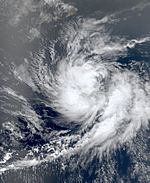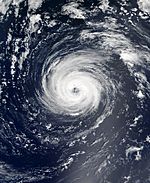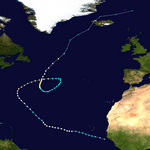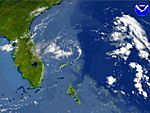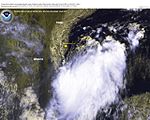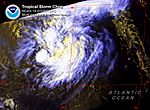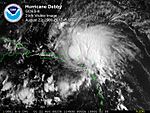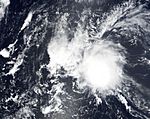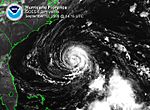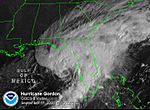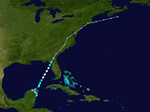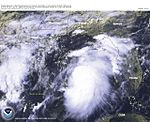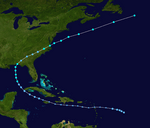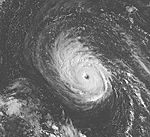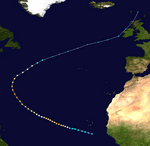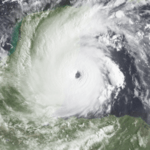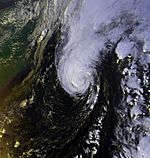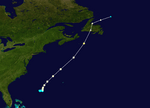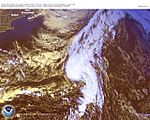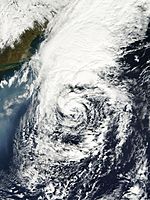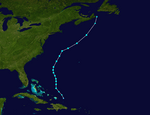Quick facts for kids
2000 Atlantic hurricane season
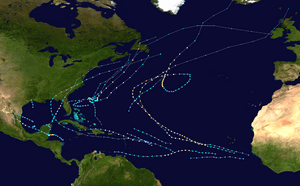 |
| Season summary map |
| First storm formed |
June 7, 2000 |
| Last storm dissipated |
October 29, 2000 |
| Strongest storm |
Keith – 939 mbar (hPa) (27.74 inHg), 140 mph (220 km/h) (1-minute sustained) |
| Total depressions |
19 |
| Total storms |
15 |
| Hurricanes |
8 |
| Major hurricanes (Cat. 3+) |
3 |
| Total fatalities |
105 total |
| Total damage |
$1.296 billion (2000 USD) |
Atlantic hurricane seasons
1998, 1999, 2000, 2001, 2002 |
| Related article |
- Timeline of the 2000 Atlantic hurricane season
|
The 2000 Atlantic hurricane season was a time when many strong storms, called hurricanes, formed in the Atlantic Ocean. This season officially began on June 1, 2000. It ended on November 30, 2000. This period is when tropical storms and hurricanes are most likely to appear.
Storms of the 2000 Hurricane Season
Tropical Depression One
| Tropical depression (SSHS) |
|
|
| Duration |
June 7 – June 8 |
| Intensity |
30 mph (45 km/h) (1-min), 1008 mbar (hPa) |
Tropical Depression One formed on June 7. It started in the southern Gulf of Mexico. This depression moved around for a short time. It then faded away on June 8. The storm brought some rain to parts of Mexico.
Tropical Depression Two
| Tropical depression (SSHS) |
|
|
| Duration |
June 23 – June 25 |
| Intensity |
35 mph (55 km/h) (1-min), 1008 mbar (hPa) |
Tropical Depression Two began on June 23. It formed near Cape Verde. Experts thought it might become a tropical storm. However, it did not get stronger. Tropical Depression Two ended on June 25. It did not come close to any land.
Hurricane Alberto
| Category 3 hurricane (SSHS) |
|
|
| Duration |
August 3 – August 23 |
| Intensity |
125 mph (205 km/h) (1-min), 950 mbar (hPa) |
Hurricane Alberto was a very long-lasting hurricane. It stayed active for almost three weeks. Its path was the second longest ever for an Atlantic hurricane. Alberto traveled nearly 6,500 miles. It formed on August 3 and ended on August 23. Its last traces were seen east of Jan Mayen.
Tropical Depression Four
| Tropical depression (SSHS) |
|
|
| Duration |
August 8 – August 11 |
| Intensity |
35 mph (55 km/h) (1-min), 1009 mbar (hPa) |
On August 8, a small depression began. This storm headed towards Florida. But then it turned around and moved back. Tropical Depression Four ended on August 11. It only brought some rain to Florida.
Tropical Storm Beryl
| Tropical storm (SSHS) |
|
|
| Duration |
August 13 – August 15 |
| Intensity |
50 mph (85 km/h) (1-min), 1007 mbar (hPa) |
Beryl was a tropical storm that started on August 13. On August 15, it reached land in Mexico. Its winds were about 50 miles per hour. Tropical Storm Beryl quickly weakened over Mexico. The storm caused one fatality and about $27,000 in damage.
Tropical Storm Chris
| Tropical storm (SSHS) |
|
|
| Duration |
August 17 – August 19 |
| Intensity |
40 mph (65 km/h) (1-min), 1008 mbar (hPa) |
Chris was a weak tropical storm. It formed on August 17. Tropical Storm Chris did not last very long. Strong wind shear caused it to break apart on August 19.
Hurricane Debby
| Category 1 hurricane (SSHS) |
|
|
| Duration |
August 19 – August 24 |
| Intensity |
85 mph (140 km/h) (1-min), 991 mbar (hPa) |
Hurricane Debby started on August 19. It mostly moved west during its life. On August 22, Debby made landfall three times. It hit Barbuda, St. Barthelemy, and Virgin Gorda. The hurricane passed just north of the Dominican Republic. It caused minor damage there.
At first, Debby was expected to hit Florida. It was thought it might be a Category 4 hurricane. Instead, Debby stayed south. It ended south of Cuba. The hurricane caused one fatality and about $735,000 in damage.
Tropical Storm Ernesto
| Tropical storm (SSHS) |
|
|
| Duration |
September 1 – September 3 |
| Intensity |
40 mph (65 km/h) (1-min), 1008 mbar (hPa) |
Tropical Storm Ernesto was similar to Tropical Storm Chris. It was short-lived and a weak tropical storm. It also ended because of wind shear. Ernesto formed on September 1 and ended on September 3.
Tropical Depression Nine
| Tropical depression (SSHS) |
|
|
| Duration |
September 8 – September 9 |
| Intensity |
35 mph (55 km/h) (1-min), 1008 mbar (hPa) |
Tropical Depression Nine was a storm that reached land in Texas. It did not have much chance to become a tropical storm. It ended on September 9, soon after hitting land.
Hurricane Florence
| Category 1 hurricane (SSHS) |
|
|
| Duration |
September 10 – September 17 |
| Intensity |
80 mph (130 km/h) (1-min), 985 mbar (hPa) |
Hurricane Florence formed on September 10. It ended on September 17, near Newfoundland. Florence created large waves in North Carolina. These waves led to three fatalities.
Hurricane Gordon
| Category 1 hurricane (SSHS) |
|
|
| Duration |
September 14 – September 18 |
| Intensity |
80 mph (130 km/h) (1-min), 981 mbar (hPa) |
Hurricane Gordon started as a tropical depression. It formed just east of the Yucatan Peninsula. It soon made landfall there. Gordon then moved into the Gulf of Mexico. It became a tropical storm. On September 17, it grew into a hurricane.
However, it weakened back to a tropical storm. It then made landfall on Cedar Key, Florida. Gordon quickly lost strength and ended on September 21. Gordon caused 26 fatalities and about $10.8 million in damage.
Tropical Storm Helene
| Tropical storm (SSHS) |
|
|
| Duration |
September 15 – September 25 |
| Intensity |
70 mph (110 km/h) (1-min), 986 mbar (hPa) |
On September 15, a tropical depression, named "Twelve," formed. It ended soon after. Its remains moved west and became a depression again on September 21. This depression then became Tropical Storm Helene. On September 22, Helene made landfall in Fort Walton Beach, Florida.
Tropical Storm Helene quickly weakened over land. It later moved back into the Atlantic Ocean. It ended on September 25. As a result of Helene, two people lost their lives. There was also about $16 million in damage.
Hurricane Isaac
| Category 4 hurricane (SSHS) |
|
|
| Duration |
September 22 – October 6 |
| Intensity |
140 mph (220 km/h) (1-min), 943 mbar (hPa) |
Hurricane Isaac was a powerful storm. It reached Category 4 strength. For its entire life, it stayed far from land. However, it caused high waves. These waves sank a boat off Long Island in New York. One person on the boat drowned.
Hurricane Joyce
| Category 1 hurricane (SSHS) |
|
|
| Duration |
September 25 – October 2 |
| Intensity |
90 mph (150 km/h) (1-min), 975 mbar (hPa) |
Joyce started as a depression on September 25. Hurricane Joyce reached its strongest as a Category 1 hurricane. It weakened back to a depression. It then passed between some of the Windward Islands. Joyce ended on October 2 in the southeast Caribbean Sea.
Hurricane Keith
| Category 4 hurricane (SSHS) |
|
|
| Duration |
September 28 – October 6 |
| Intensity |
140 mph (220 km/h) (1-min), 939 mbar (hPa) |
Hurricane Keith was the strongest hurricane of the 2000 Atlantic hurricane season. Keith hit Belize and Mexico. It ended on October 6. Keith caused 40 fatalities and $319 million in damage. Most of this damage happened in Belize. This was because it hit Belize when it was stronger than when it hit Mexico.
Tropical Storm Leslie
| Tropical storm (SSHS) |
|
|
| Duration |
October 4 – October 7 |
| Intensity |
45 mph (75 km/h) (1-min), 1006 mbar (hPa) |
Tropical Storm Leslie began as a subtropical depression. It formed over Central Florida. Leslie did not get very strong before it ended on October 7. The low pressure system that created Leslie caused almost $1 billion in damage.
Hurricane Michael
| Category 2 hurricane (SSHS) |
|
|
| Duration |
October 15 – October 20 |
| Intensity |
100 mph (155 km/h) (1-min), 965 mbar (hPa) |
Michael started on October 15 as a subtropical depression. It moved slowly at first. Then it moved faster and got stronger. It made landfall in Newfoundland as a Category 1 hurricane. Michael ended very soon after. No damage or fatalities were reported from this storm.
Tropical Storm Nadine
| Tropical storm (SSHS) |
|
|
| Duration |
October 19 – October 21 |
| Intensity |
60 mph (95 km/h) (1-min), 999 mbar (hPa) |
Nadine started as Tropical Depression Eight on October 19. It was located 600 miles from land. It never got closer than that. Nadine became a tropical storm. It ended on October 21.
Unnamed Subtropical Storm
| Subtropical storm (SSHS) |
|
|
| Duration |
October 25 – October 29 |
| Intensity |
65 mph (100 km/h) (1-min), 976 mbar (hPa) |
This Subtropical Storm was the last storm of 2000. It began on October 25 as a subtropical storm. It moved near Nova Scotia and Newfoundland. However, it ended on October 29 before reaching those places.
Storm Names Used in 2000
The names below are the full list of storm names used in 2000. This list is the same as the one from the 1994 Atlantic hurricane season. This is because no names were removed from the list in 1994.
- Alberto
- Beryl
- Chris
- Debby
- Ernesto
- Florence
- Gordon
|
- Helene
- Isaac
- Joyce
- Keith
- Leslie
- Michael
- Nadine
|
- Oscar (unused)
- Patty (unused)
- Rafael (unused)
- Sandy (unused)
- Tony (unused)
- Valerie (unused)
- William (unused)
|
Name Retirement
In the spring of 2001, the name Keith was officially "retired." This means it will not be used again for a hurricane. The name Kirk replaced Keith in the 2006 season.
|
Tropical cyclones of the 2000 Atlantic hurricane season
|
|
|
|
|
|
Other Hurricane Seasons
Images for kids
-
Hurricanes Isaac and Joyce on September 27, 2000
See also
 In Spanish: Temporada de huracanes en el Atlántico de 2000 para niños
In Spanish: Temporada de huracanes en el Atlántico de 2000 para niños

 In Spanish: Temporada de huracanes en el Atlántico de 2000 para niños
In Spanish: Temporada de huracanes en el Atlántico de 2000 para niños



